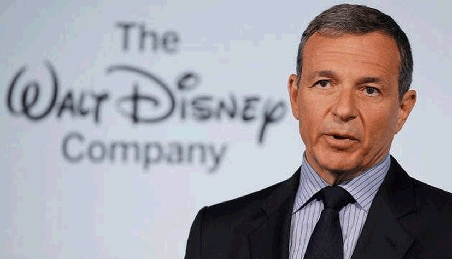Disney’s self-disruption success saga
With Bob Iger stepping down as CEO of The Walt Disney Company, Center director Jeffrey Cole examines Iger’s extraordinary legacy and the lessons other CEOs can learn from it.
By Jeffrey Cole
Last week, after 15 extraordinary years, Bob Iger handed over the reins as CEO of The Walt Disney Company to the relatively unknown (outside Disney) Bob Chapek. The timing of the announcement—and the fact that it occurred in the middle of a Tuesday afternoon and took place immediately—caught everyone by surprise and raised a few questions. It also marked the beginning of the end of one of the most important and consequential eras of leadership in the history of the entertainment industry—or any industry.
 Our work in looking at how companies and industries grapple with disruption shows few if any examples of successful companies disrupting themselves. Most CEOs, when faced with an existential threat (taxis vs. Uber, music vs. Napster) or a new way to doing business (Kodak, Blockbuster), almost always double down on the old ways and try to fight the tidal wave of disruption.
Our work in looking at how companies and industries grapple with disruption shows few if any examples of successful companies disrupting themselves. Most CEOs, when faced with an existential threat (taxis vs. Uber, music vs. Napster) or a new way to doing business (Kodak, Blockbuster), almost always double down on the old ways and try to fight the tidal wave of disruption.
What distinguishes Iger as a great leader and promises a long legacy was his understanding—when he took over a very profitable Disney in 2005—that the company had to disrupt itself.
Although Disney was wildly successful, Iger saw that it was too small to compete effectively against the emerging tech giants who were sure to grow like weeds and eventually enter the entertainment business as competitors.
Iger simultaneously pursued two strategies that defined his vision and success as Disney’s best CEO, probably since Walt Disney himself.
First, he had to bulk up Disney to make it much larger if it was going to survive well into the 21st Century.
Second, technology was at the core of his vision from his first days as CEO, and it reached its zenith at the end of last year.
Pixar, and Marvel, and Star Wars… oh my!
One of the first things Iger did as CEO was to make peace with Steve Jobs, who was threatening to take Pixar’s hugely profitable film distribution to another studio. Jobs was unhappy with Iger’s predecessor, Michael Eisner, and wanted to find a new home for his tech-based studio that had never had a film that was not a huge hit.
A few days into his tenure, Iger flew to Silicon Valley to meet with Jobs, keeping the distribution relationship with Pixar and setting the stage for the full acquisition of Pixar less than a year later for $7.4 billion—a superb addition to Disney.
Perhaps in his blossoming relationship with Jobs, Iger got a sense of soon-to-be developed smartphones, tablets, and other technologies that shaped his belief that Disney’s future was in technology.
___________________________________________________________________________
A successful movie studio CEO—who embraces disruption and makes the changes that are best for the long-range interests of the company—is even rarer than a studio sharing net profits with the participants of a film. This is what really distinguishes Iger’s term as CEO.
___________________________________________________________________________
Later, the studio continued to bulk up with the acquisitions of Marvel Studios in 2009 for $4.24 billion and Lucasfilm (Star Wars) in 2012 for $4 billion. These acquisitions took Disney to levels no other studio had ever seen. In 2019, seven of the ten top-grossing films world-wide came from Disney; five crossed the billion-dollar mark. In a complete validation of Iger’s bulking-up strategy, five of the seven came from the Pixar, Marvel, and Lucasfilm acquisitions.
Tech tok, tech tok
Iger’s bet on technology started with Pixar, continued with the restored importance of the Disney Imagineers, went a step further with the acquisition of the streaming technology company BAMtech, and reached its greatest point with the introduction of Disney+ last November.
Iger was the first studio chief to realize that licensing Disney’s library to Netflix, while enriching Disney’s coffers in the short term, was also creating its biggest rival. In 2017, Disney stopped selling to Netflix. Soon after, Disney announced it would start its own streaming service. Disney was first to understand the new landscape that Netflix had created. Apple, CBS, and others followed, with more soon to come.
The Iger lesson: disrupt yourself before somebody else does
The decision to stop selling to Netflix may have produced a $150-200 million loss for Disney. Even having launched Disney+ in late 2019, it might take until 2022 or later to overcome that hit. This is the sign of a real leader dealing with a massive wave of disruption. Most CEOs are focused on the next 24 months and especially the next quarter. A self-inflicted wound of $200 million frequently leads the board to look for a new CEO.
A successful movie studio CEO—who embraces disruption and makes the changes that are best for the long-range interests of the company—is even rarer than a studio sharing net profits with the participants of a film. This is what really distinguishes Iger’s term as CEO. He built the company to thrive against tech giants such as Apple, Amazon and Google. When he had to disrupt the company’s revenues by refusing to sell to Netfix, the rest of the company was strong enough, through the film acquisitions (and Disney’s native films), as well as television and theme parks, to give him the latitude to do what was necessary.
In 2019 Disney added immeasurably to its size by absorbing most of Fox’s film and television assets for $71 billion, taking the studio count down from six to five. A few things done differently in the preceding 15 years might have seen Rupert Murdoch’s Fox acquiring Disney rather than the other way around.
When Iger bet the company on Disney+ (a good bet in our view), it was the culmination of smart twin strategies to bulk up the company and embrace technology well before everyone else.
Although Disney could be acquired by an even larger company (we have speculated about Apple abandoning its weak entertainment effort and just buying Disney), it is a testament to Disney’s strategy that it is so attractive.
Whatever happens with Disney, in 2005 Iger understood the surge of disruption that the company would face. Disney embraced rather than fought disruption, and that has made it the entertainment, media and technology powerhouse that it is today.
For every other CEO of a large company, regardless of its industry, there is a lot to learn from Disney 2005-2020.
____________

Jeffrey Cole is the founder and director of The Center for the Digital Future at USC Annenberg.
See all columns from the center.
March 4, 2020

